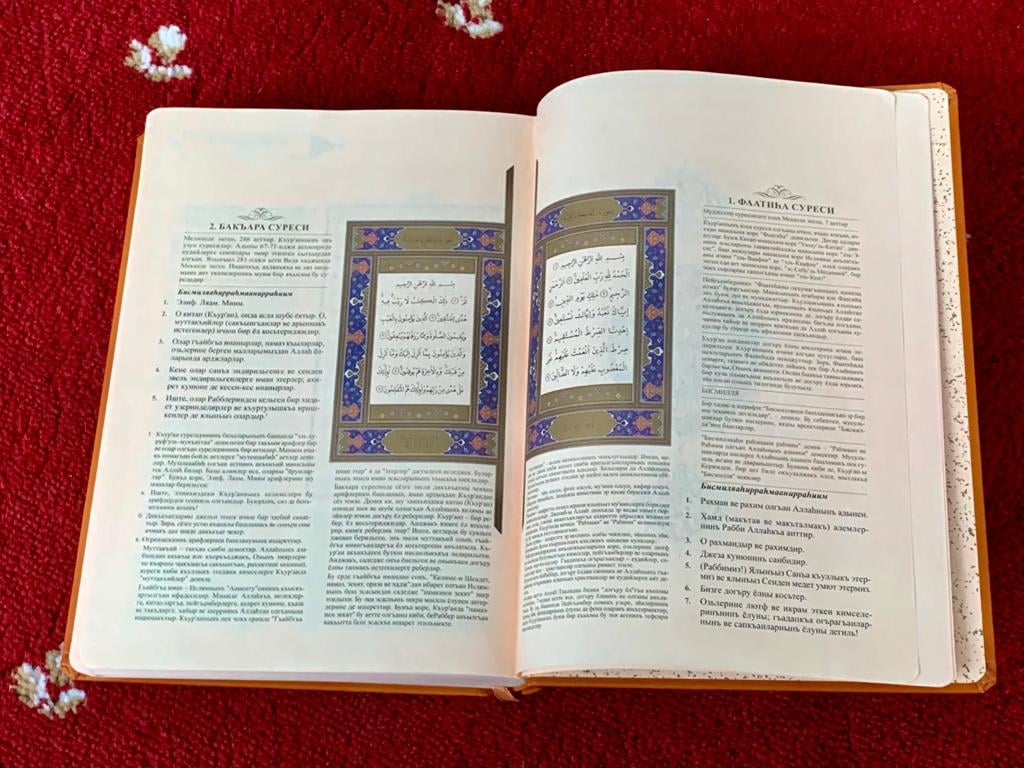With around 600,000 native speakers in present-day Ukraine, Uzbekistan, and Turkey and Romania, the Crimean Tatar language is among the world’s endangered languages. With at least half of its speakers living in Crimea, any news of religious translations draws great attention and tends to be seen by Crimean Tatars as a step towards the preservation of religious and cultural identity. Suffering from heavy losses after Crimean Tatars were deported to Central Asia by Stalin’s regime in 1944, the opportunity to return to their homeland in the late 80’s led to great interest in the Islamic past and present. That is why the first contemporary translation of the Qur’an into Crimean Tatar was been carried out at the start of the 90’s in Uzbekistan and from the Uzbek language by well-known Crimean Tatar writer Riza Fazıl (1928–2016). A second, more widely distributed translation appeared in 1998, then republished in 2005 and 2007 in Crimea. A final edition of 2015 in Ankara (Turkish Directorate of Religious Affairs, TDRA) adds the Arabic text. A collaboration between Turkish theologian Said Dizen and Crimean Tatar writer Zakir Kurtnezir (1933–2016), the translation received publishing approval from the local Religious Board of Crimean Muslims. Nowadays, the translation is not only distributed in printed form, but is also available on some Muslim websites.
All editions use Cyrillic letters, despite the strong preference among present-day Crimean Tatars for the Latin alphabet. This may be to cater for all generations of Crimean Tatars, since older members of the community may find Latin letters difficult to use. As well as a formal introduction by Crimean mufti Emirali Ablaev, there is an introduction by the translators. As is typical, they emphasise that ritual recitation of the Qur’an is only in Arabic, while their work is only an interpretation. Another section informs us that the translator referred not only to the Arabic text but also other translations, including 3 popular Turkish works (Abdullah Aydın, 1992, Ali Özek, 1993, Medine Balcı, 1995) and 2 in Russian (Ignatij Krachkovsky, 1963, Valeriia Porokhova, 1991).
Among tafsir works, the translator states they followed the method of one of the most popular 20th century Turkish textbooks: “Tefsir Usulü” by İsmail Cerrahoğlu (1971). More than a theoretical treatise, it has plentiful examples of interpretation of particular verses. The modern Turkish tradition of Qur’an interpretation has influenced this translation greatly: there are short intros to the suras, frequent insertions, and transliterated Qur’anic vocabulary, especially Arabic words existing as loans in both Turkish and Crimean Tatar languages. This makes a contrast with the earlier translation, where “Turkic” religious vocabulary was used. E.g. Riza Fazıl writes for 2:11, “”Olarğa: “Yer yüzünde bozğguncılık yapmañız”, denilgende: “Bizler eyilik yapqanlardanmız”, – deyler”. In contrast, Dizen and Kurtnezir write: “Olarğa: “Yer yüzünde fesat çıqarmañ”, denilgen vaqıtta: “Biz yalıñız islâh eticilermiz”, derler” – one may see the usage of Arabic roots (fesat, islâh) following the Qur’anic wording: “Wa-idha qila lahum la tufsidu fi l-ardi qalu innama nahnu muslihun”. (“When it is said to them, ‘Do not cause corruption in the land,’ they say, ‘We are only putting things right’” – M.A.S. Abdel Haleem translation). If religious terms of Arabic origin are obscure for some of the readership (their wide use in past centuries overtaken by 20th century “secularization strategies” towards some Turkic languages), this is largely resolved by footnotes. An example is Allah Sameddır (112:2) with the subsequent explanation. Moreover, the appendix to the translation has more than 500 religious terms explained – this could be useful case for readers not well-versed in their native language and religious terms. Just after this appendix, one may see an invocation recited upon completing the reading of the Qur’an (du’a khatm al-Qur’an). While that a standard addition to the text in all the translations appeared from TDRA, some of the previous editions from Crimea also included an invocation for the homeland in the Crimean Tatar language, reflecting how much religious revival of Crimean Tatars is connected to the national one. According to news recently received from the Religious Board of Crimean Muslims, there will be a new edition based on this one, with more attention to the Arabic text and classical tafsir corpus; however, the work is still far from completion. Thus, apart from the rendition of Riza Fazıl, the translation of Said Dizen and Zakir Kurtnezir seems to be the only domestic alternative to the widely-read Turkish and Russian translations in Crimea.
Mykhaylo Yakubovych


